daveh
Lifetime Member
  
Posts: 4,696
|
Post by daveh on Mar 14, 2011 21:04:10 GMT -5
Well for the Chinese it is the year of the rabbit. For us on here it seems to be the year of the scanner. I nearly parted company with my HP scanner last year. The provided software was poor, scans would go missing (though there was a later patch for this) and I never seemed able to scan negatives or slides through Photoshop. I tried Vuescan, which was better, but I wasn't overly impressed with the results. However, I have loaded the latest HP drivers and the most recent Vuescan update and suddenly everything is tickety-boo. I can now scan thirty 35mm negatives in one batch (if they have been cut in strips of six). The trouble is I spent forever getting rid of any dust specks. Egypt, Valley of the Kings, Pentax SFX, February 2000, colour negative stock.   Temple of Hatshepsut   I never did find out if the repairs were, as it were, normal ongoing repairs, or made necessary by the terrorist attack on the tourists the previous year. I tell a lie, these weren't taken with the SFX. I realise that I am holding it in a couple of the photos. I presume then they must have been on the SF7 - I had reversal film in the SFX - and the camcorder too. |
|
|
|
Post by John Farrell on Mar 15, 2011 14:29:04 GMT -5
I'm treating my scans as a digital proof sheet, so I don't feel obligated to clean them up.
|
|
daveh
Lifetime Member
  
Posts: 4,696
|
Post by daveh on Mar 15, 2011 14:50:41 GMT -5
John,
I suppose I'm fairly "lucky" in that most of my old negatives have gone missing. Most I of those I'm scanning will have only been out of the storage sleeves a couple of times, so, as long as I make sure there isn't too much dust on the scanner, there isn't too much to do. Some of the few older negatives are a bit more battered and need a good deal longer on them. As you have done, I won't bother as much with these, other than the few I'll "blow up".
Dave.
|
|
|
|
Post by colray on Mar 15, 2011 22:10:48 GMT -5
Now I wonder if I should invest in one of those scanners?
|
|
|
|
Post by nikonbob on Mar 16, 2011 7:26:50 GMT -5
Dave
Thanks for posting these. I think it would be an interesting experience going to Egypt. I think HP has a reputation of not being quick to update drivers for their scanners or printers. I just went to a new PC with Win7 and have had a bad time with my HP printer which I really like. It is running now but not in the same way as before. No trouble with my Epson flat bed scanner though. The other scanner that I have trouble running is an old Minolta 5400 Mk1 but that is to be expected considering Minolta is out of business.
Col
There is another option to buying a scanner that may be available to you. There s a drugstore chain here that will develop your film and give you a CD with no prints for a reasonable amount. Of course if you already have lots of negs that won't help much. The good thing is that scanners are relatively cheap these days.
Bob
|
|
daveh
Lifetime Member
  
Posts: 4,696
|
Post by daveh on Mar 16, 2011 7:50:12 GMT -5
Thanks, Bob.
I feel Epson has the edge over HP in the scanning field.
If there are lots of negatives or slides to scan, then one with full bed capability is well worth the extra.
|
|
Wahoo
Senior Member
  Danny
Danny
Posts: 95
|
Post by Wahoo on Apr 29, 2011 15:25:40 GMT -5
I feel Epson has the edge over HP in the scanning field. In the distant past I've bought a few scanners but it's one of those things I've never mastered. I still have a bunch of Epson's and about a half dozen Microtek 4000tf's and a Nikon ED 8000 that I've yet to use. 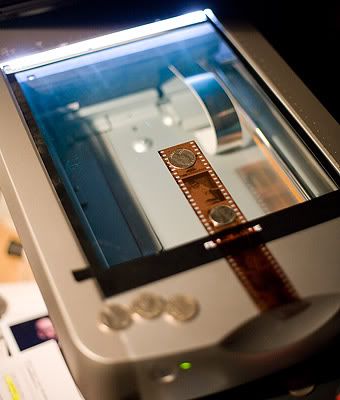 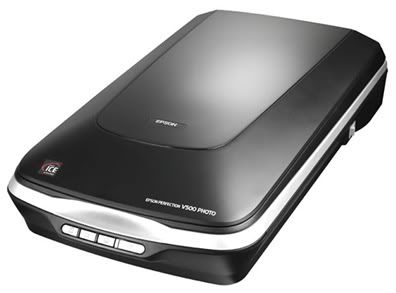 Danny Forgot to include my name . ;D PS Nice photos Dave, you are definitely better at scanning than me and I thought PeterW's recent 4990 scans were excellent. |
|
mickeyobe
Lifetime Member
   Resident President
Resident President
Posts: 7,280
|
Post by mickeyobe on Apr 29, 2011 17:36:03 GMT -5
There used to be a brush called a Staticmaster that I used to remove dust from my negatives and slides. It supposedly contained a radioactive element. It was very effective. I still have it but, after 15 or 20 years it doesn't do its magic any more.
It was made by Nuclear Products Company of El Monte California.
Hmmm. I wonder if that is why most of my hair is gone.
Mickey
|
|
PeterW
Lifetime Member
   Member has Passed
Member has Passed
Posts: 3,804
|
Post by PeterW on Apr 29, 2011 18:11:51 GMT -5
Thanks for the compliment, Danny.
I was actually given my Epson 4990 which was fortunate as when I upgraded from Windows XP to Windows 7 I couldn't find an Epson driver for my older Epson which I had for years.
I tried Vuescan but didn't like it as much as Epson's own driver which I now use. I can use Photoshop's Import command to choose it.
I had to increase the memory in my (slightly modified) HP computer to 2GB to use the higher resolution scans (above 600 ppi) comfortably if I had more than one window open on the screen.
I've given my old Epson to a friend who is running Windows XP.
PeterW
|
|
|
|
Post by nikonbob on Apr 29, 2011 18:34:24 GMT -5
If anyone is having trouble using an old Minolta scanner with Win7 try downloading a trial version of Vuescan and tell your PC to use the Vurscan drivers when it can't find a driver for the Minolta software. I did this for the old Minolta 5400 Mk1 and it ran, sort of. I then checked the compatibility mode in the properties of the Minolta software. It was set to XP service pack 3 so changed it to Win7 and it now runs like it did with my old XP PC. Just waiting to see if the drivers disappear in the Minolta software when the Vuescan trial ends.
Bob
|
|
Deleted
Deleted Member
Posts: 0
|
Post by Deleted on Apr 29, 2011 22:03:14 GMT -5
Anyone new to scanning needs to know that no scanning software can automatically remove dust and scratches from black and white, silver-based film. The work OK wit non silver C-41 B&W, however. It has something to do with the way light reflects off silver particles.
Wayne
|
|
daveh
Lifetime Member
  
Posts: 4,696
|
Post by daveh on Apr 29, 2011 22:53:52 GMT -5
Danny, Thanks, but I'm not sure the compliment is justified. The object as scanned is often not that clear - often it is only after processing in Photoshop that things are revealed in their true glory. I know what Peter means about Vuescan. It is somewhat difficult to "get into", but is good once you have. If you choose to save the RAW file you can process that file in Vuescan itself. I have done some scans at my HP's maximum of 4800 dpi. The result is 30 mega pixels from a 35mm negative. It's not something you want to do all the time, but it does show how much information 35mm film is capable of holding. Photoshop is wonderful for for dust and scratch removal. Unless the original is heavily disfigured I don't use the automatic removal sysytems. The spot healing brush set to "content aware" makes almost any blemish a doddle to remove once you have sussed it out fully. If anyone wants Photoshop:- 1) illegal version - download a trial then alter a line or two in the registry so it thinks it has been legally activated 2) cheap legal version - available from China for $99 US (I think). It comes in a proper box and certainly registers and activates without problem. I have the address for this somewhere or other. From a negative, as scanned:  after photoshopping:  I'm sure I could get the scan to come out better than it has, but contrasting the two does illustrate how much we have to thank the likes of photoshop for. Mickey, I have one of those radioactive dust brushes too. Obviously the half-life wasn't log enough on them - mine has died as well, though the brush on its own is still useful. Dave. |
|
PeterW
Lifetime Member
   Member has Passed
Member has Passed
Posts: 3,804
|
Post by PeterW on Apr 30, 2011 16:30:57 GMT -5
Hi, I agree with Dave that the automatic blemish removal, and for that matter automatic descreening, of most scanning software isn’t all that effective. I much prefer to do a straight scan and then use Photoshop, in my case CS3. To pass on a few tips that might help some people I scanned in the rather battered front cover of a 50-year old Autocar magazine and took just a small portion of it to show the sort of thing I mean – within my own limitations. No doubt someone like Katrin Eisenstein could do a better job. Here’s the original straight scan of the A4 front cover, scanned at 600 ppi – no dust removal, no descreening. 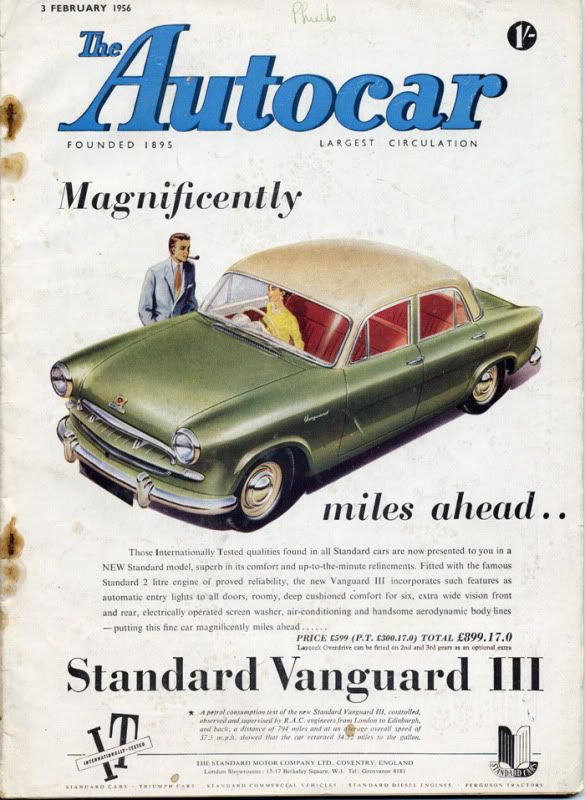 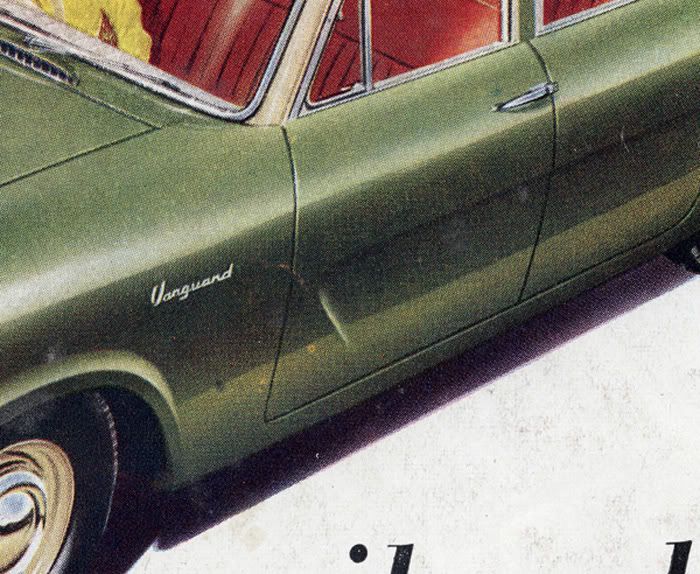 I picked a small portion around the front door to illustrate this posting. 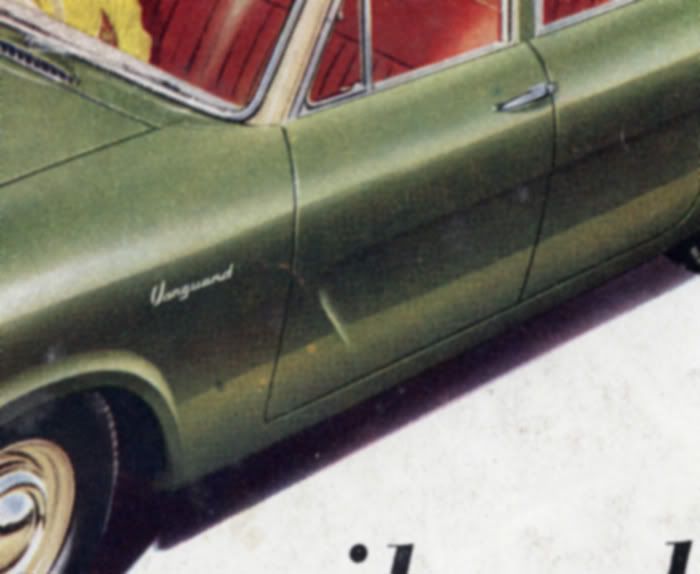 First job was to descreen it using Filter -> Blur -> Gaussian Blur. As Dave said, the Healing Brush is a very useful tool and will do an excellent job in many cases, but look at the white blemish on the door across the line where the green changes from dark to light. Using the healing brush here is a bit like putting a chameleon on a tartan. It doesn’t know which background colour to choose. 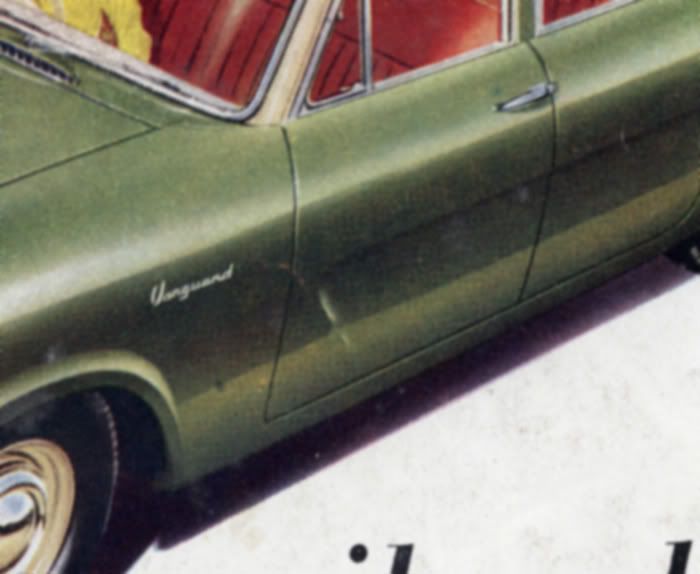 A case like this is is where I use the rubber stamp Clone Tool with a soft-edged brush. When you’ve chosen the brush size (use the left and right square brackets) position the brush next to the blemish and hold down the Alt key. The brush changes to a small circle with cross-hairs. Position the cross hairs on the colour-change (or contrast-change) line near the blemish and click. Still holding down the Alt key, move the brush so the cross hairs are in the blemish along the colour-change line. Now let the Alt key go and click. With a spot of practice you can get the colour-change line in the right place. 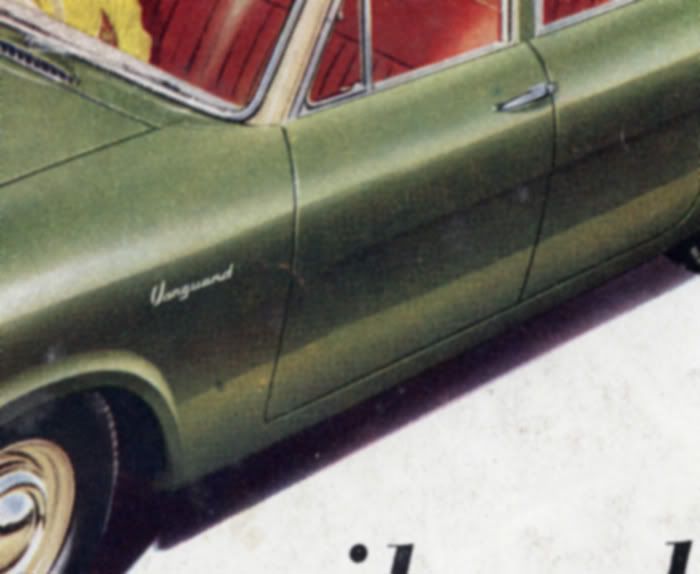 Then I used the Clone Tool to take out the rest of the blemish either side of the colour-change line. 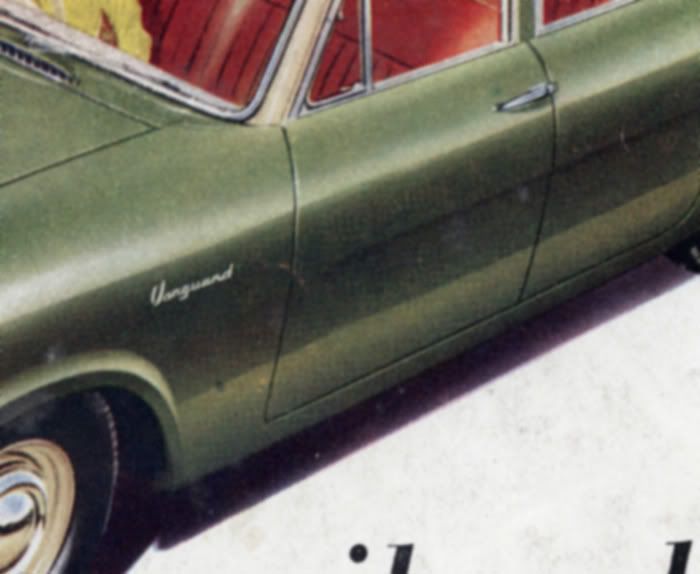 I adjusted the colour slightly by using Image -> Adjustment -> Hue Saturation to alter the saturation of the green and yellow channels to give a less garish brightness to the image. 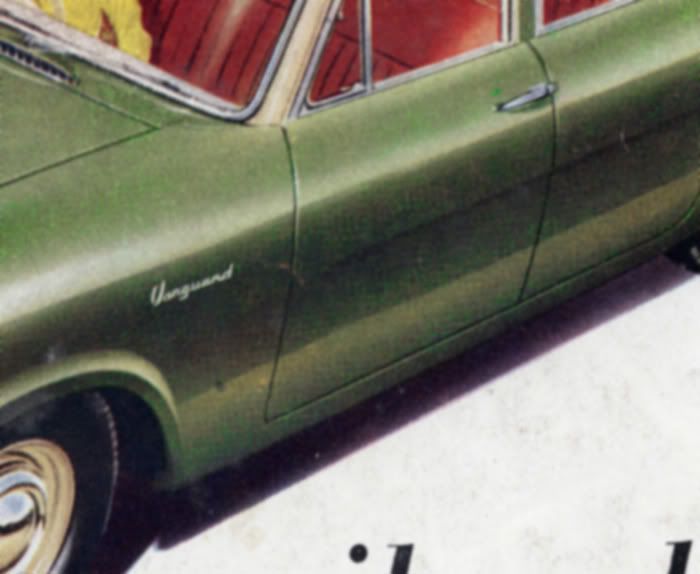 Finally I used Filter -> Sharpen -> Unsharp Mask with a setting of about 50% and one pixel radius. Normally I would take out all the other blemishes, including the grubbiness of the white background, before the last two steps, but in this case I didn’t bother. I know it doesn't look so "sharp" as the original, but screens in 1956 were coarser than they are today, and it's an enlarged portion of an A4 scan. At its original A4 size the difference in "sharpness" is hardly noticeable - and it won't print with a moire pattern with either laser or offset litho printing. Other cases where I’ll use the Clone Tool rather than the Healing Brush to take out blemishes are a fabric, like knitted wool or lace, or on wood with a nice grain. It retains the texture instead of giving an averaged-out blob of plain colour. Hope this mini-tutorial may be of some help to some of you. It sounds a lot of work, but with practice it’s surprising how quickly you can go over an image with the Clone Tool to take out all the unwanted spots, scratches and other blemishes that defeat the Healing Brush. There are a lot of other little tricks and dodges I use, which aren't in Adobe's handbook, to make prints from old magazines and books, damaged photographs and damaged negatives suitable for modern ink jet or laser printing and web offset reproduction. If anyone's interested I'll post some from time to time. It's sometimes amazing what can be done but even Photoshop, wonderful program that it is, can't yet perform miracles - at least not in my hands. PeterW |
|
PeterW
Lifetime Member
   Member has Passed
Member has Passed
Posts: 3,804
|
Post by PeterW on Apr 30, 2011 20:39:49 GMT -5
You weren't supposed to keep it in your shirt pocket, Mickey ;D. I always give a strip of negatives a sharp edge-ways tap on the desk before scanning. This seems to help destroy the static, and I wipe them afterwards with a microfibre cloth. I don't seem to suffer very much from dust on the negs. I must admit that sometimes I treat my old negs a bit roughly, but then you've got to show them who's boss.  PeterW |
|
daveh
Lifetime Member
  
Posts: 4,696
|
Post by daveh on May 2, 2011 17:56:46 GMT -5
Peter, The spot healing brush on CS5 is a big improvement on that of earlier versions of photoshop. It will reproduce all sorts textures and colours if set to "content aware". Contrary to its designation "spot" it can be used in a run. Here is your door with one run of the spot healing brush:  It doesn't always "guess" right, but sometimes its ability to fill in lost segments is quite remarkable. |
|